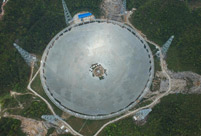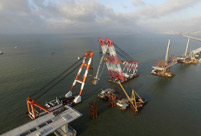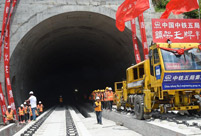

BEIJING, July 13 -- China successfully carried out test flights on two new airports on the Nansha Islands in the South China Seaon Wednesday, further enhancing its capability to provide public services as a responsible player in the region.
Together with the one on Yongshu Reef, the two airfields, respectively located on Meiji Reef and Zhubi Reef, bring tangible benefits to vessels sailing in and planes flying over the area, thanks to their convenient location in the middle of the vast water body.
While over 100,000 vessels across the world -- that is about 50 percent of the world's commercial shipping -- sail through the South China Sea every year, the region severely lacks the necessary infrastructure to ensure a safe passage.
Moreover, airports located in the middle of the sea that can accommodate large passenger jets can undoubtedly provide more options for aircraft if an emergency occurs, as the airspace above the sea is one of the world's most congested.
When Malaysia Airlines flight MH370 carrying 239 people went missing in March 2014, it took the rescue vessels and aircraft quite some time to arrive at the spots initially believed to be where the flight went missing in the vast sea. Land bases like Meiji Reef and Zhubi Reef could have significantly reduced the time it took the rescuers to arrive there.
In fact, China has traditionally been charged with providing public services on the Nansha Islands, such as radio stations, observations and lighthouses. And the country also conducts important search and rescue missions in the relatively enclosed sea.
Accordingly, its recent building activities on the Nansha Islands, including on Meiji Reef and Zhubi Reef, are only the natural extension of the efforts made by China to provide necessary service for vessels and sailors in the region.
As the award on a controversial arbitration over the China-Philippine territorial dispute was announced by an arbitral tribunal one day ago, Wednesday's test flights may be seen by some as a direct response to it.
But that is not true.
The timing of the test flights for the two airports was preset and independent of the unfounded arbitration. Since the test flights were made on reefs belonging to China, it was purely an internal matter for the country. Even if China were to test fly warplanes, doing so would still be within its legitimate rights.
What's more, the arbitration was nothing but a political farce perpetrated by the former Philippine government. The arbitral tribunal was practising outside of its jurisdiction, not to mention the fundamental factual and procedural errors it made during its handling of the case.
A null and void award naturally has no impact on China's actions.
 "Straddling bus" starts production in east China
"Straddling bus" starts production in east China Girl goes viral for finger-long toes
Girl goes viral for finger-long toes Five made-in-China hi-tech breakthroughs
Five made-in-China hi-tech breakthroughs HK-Zhuhai-Macao Bridge to open to traffic
HK-Zhuhai-Macao Bridge to open to traffic China opens its first combined transport service to Nepal
China opens its first combined transport service to Nepal Students take stylish bikini graduations photos
Students take stylish bikini graduations photos Charming dancing students pose for graduation photos
Charming dancing students pose for graduation photos Guizhou, Yunnan section of Shanghai-Kunming railway connected
Guizhou, Yunnan section of Shanghai-Kunming railway connected Naked models transformed into landscapes, birds and even DRAGONS by body painting artist
Naked models transformed into landscapes, birds and even DRAGONS by body painting artist Top 20 hottest women in the world in 2014
Top 20 hottest women in the world in 2014 Top 10 hardest languages to learn
Top 10 hardest languages to learn 10 Chinese female stars with most beautiful faces
10 Chinese female stars with most beautiful faces China’s Top 10 Unique Bridges, Highways and Roads
China’s Top 10 Unique Bridges, Highways and Roads Arbitration award more shameless than worst prediction
Arbitration award more shameless than worst prediction S.China Sea verdict 'null and void' with no binding force: FM
S.China Sea verdict 'null and void' with no binding force: FM Without a support system, expat mothers are more vulnerable to postpartum depression
Without a support system, expat mothers are more vulnerable to postpartum depression Tasty tiger
Tasty tigerDay|Week